Practice Decision Making in Health and Social Care
VerifiedAdded on 2021/02/21
|12
|4163
|60
AI Summary
Contribute Materials
Your contribution can guide someone’s learning journey. Share your
documents today.
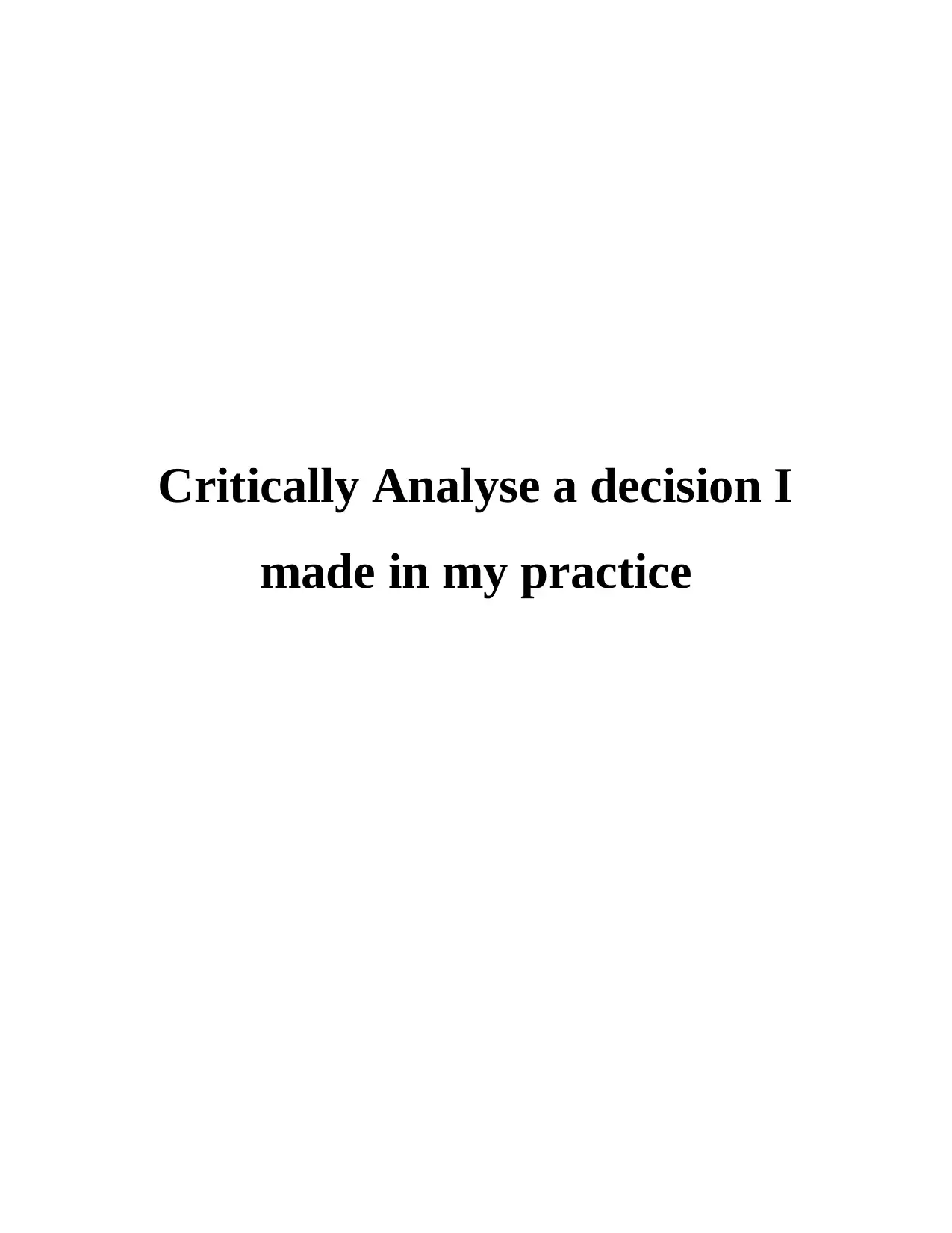
Critically Analyse a decision I
made in my practice
made in my practice
Secure Best Marks with AI Grader
Need help grading? Try our AI Grader for instant feedback on your assignments.
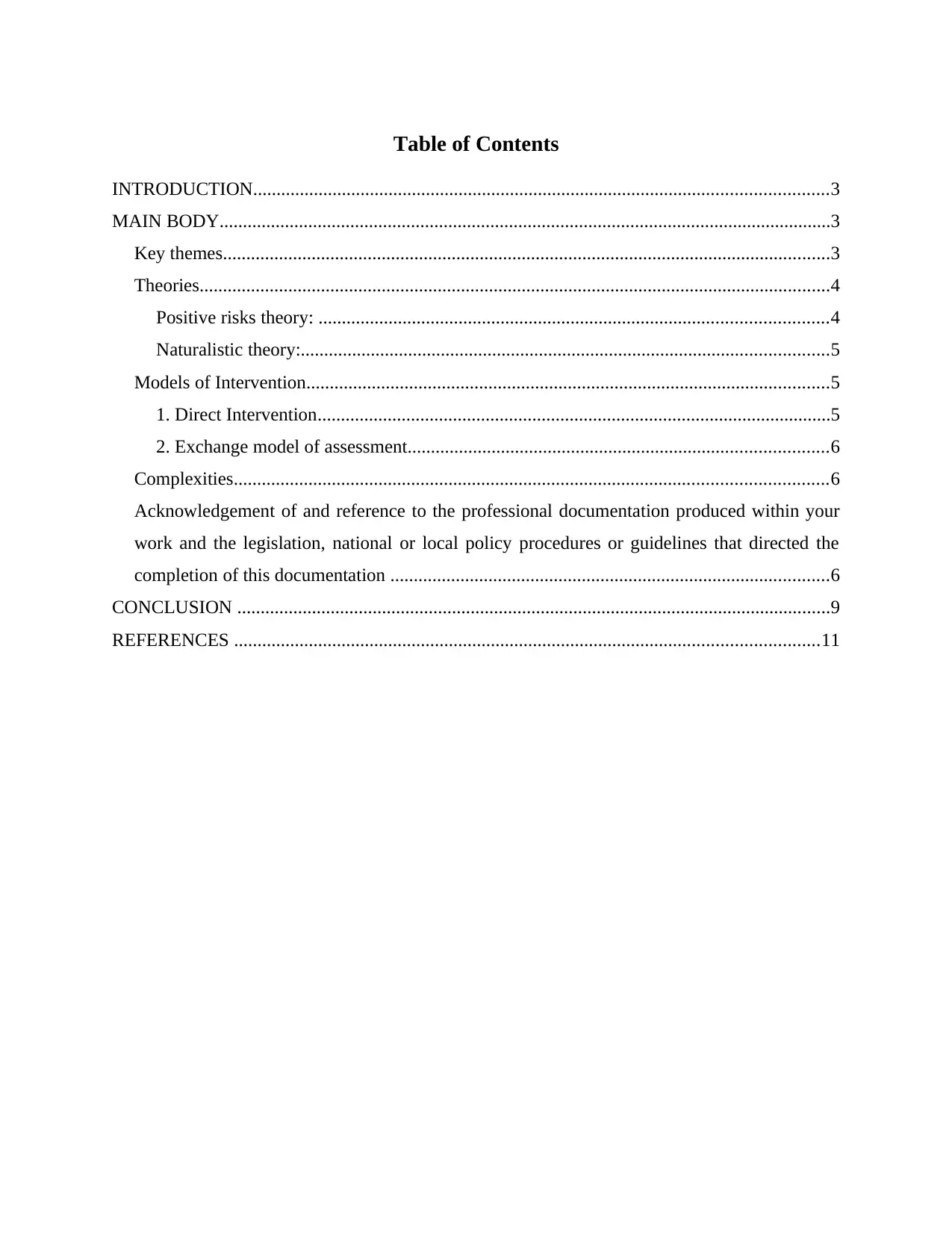
Table of Contents
INTRODUCTION...........................................................................................................................3
MAIN BODY...................................................................................................................................3
Key themes..................................................................................................................................3
Theories.......................................................................................................................................4
Positive risks theory: .............................................................................................................4
Naturalistic theory:.................................................................................................................5
Models of Intervention................................................................................................................5
1. Direct Intervention..............................................................................................................5
2. Exchange model of assessment..........................................................................................6
Complexities...............................................................................................................................6
Acknowledgement of and reference to the professional documentation produced within your
work and the legislation, national or local policy procedures or guidelines that directed the
completion of this documentation ..............................................................................................6
CONCLUSION ...............................................................................................................................9
REFERENCES .............................................................................................................................11
INTRODUCTION...........................................................................................................................3
MAIN BODY...................................................................................................................................3
Key themes..................................................................................................................................3
Theories.......................................................................................................................................4
Positive risks theory: .............................................................................................................4
Naturalistic theory:.................................................................................................................5
Models of Intervention................................................................................................................5
1. Direct Intervention..............................................................................................................5
2. Exchange model of assessment..........................................................................................6
Complexities...............................................................................................................................6
Acknowledgement of and reference to the professional documentation produced within your
work and the legislation, national or local policy procedures or guidelines that directed the
completion of this documentation ..............................................................................................6
CONCLUSION ...............................................................................................................................9
REFERENCES .............................................................................................................................11
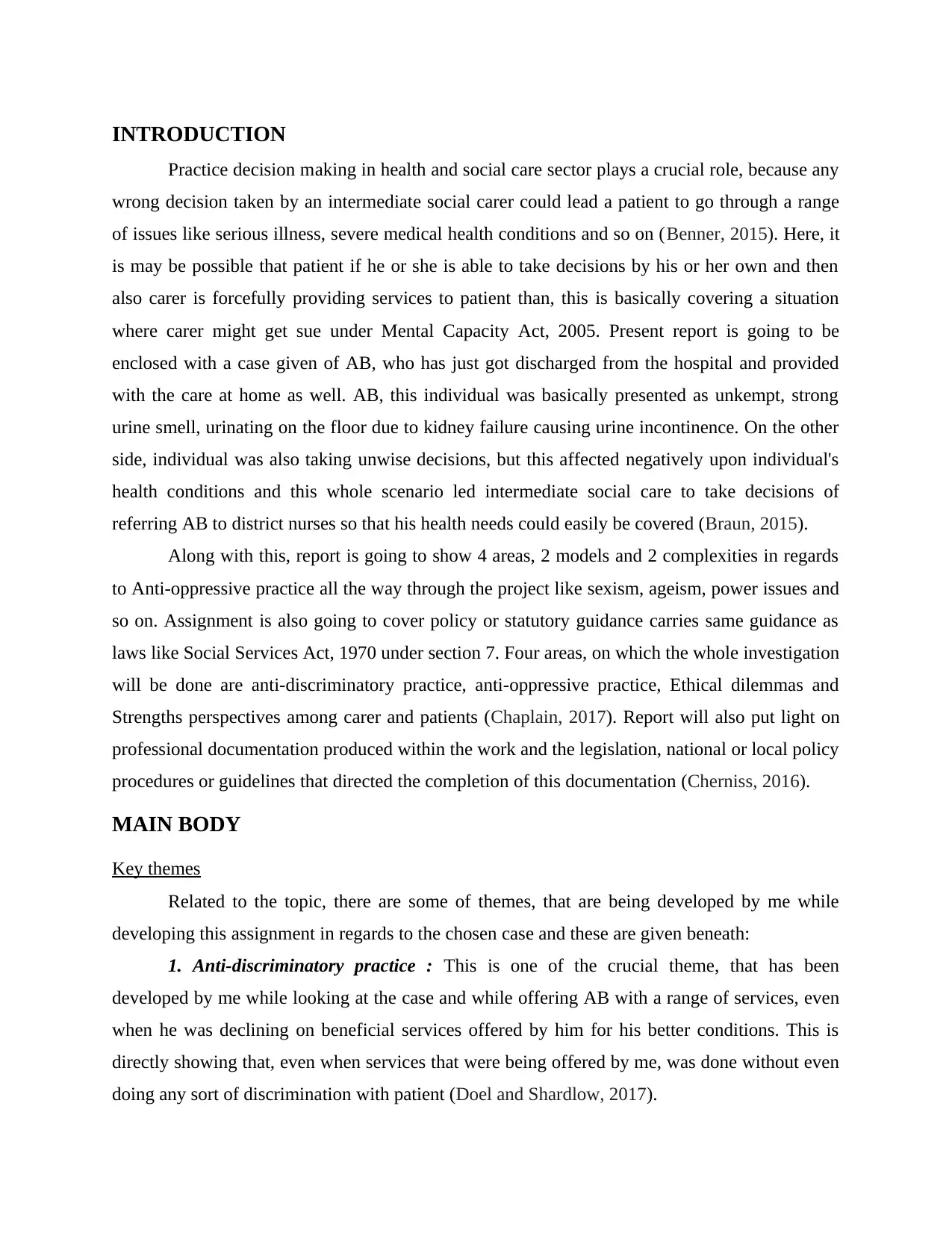
INTRODUCTION
Practice decision making in health and social care sector plays a crucial role, because any
wrong decision taken by an intermediate social carer could lead a patient to go through a range
of issues like serious illness, severe medical health conditions and so on (Benner, 2015). Here, it
is may be possible that patient if he or she is able to take decisions by his or her own and then
also carer is forcefully providing services to patient than, this is basically covering a situation
where carer might get sue under Mental Capacity Act, 2005. Present report is going to be
enclosed with a case given of AB, who has just got discharged from the hospital and provided
with the care at home as well. AB, this individual was basically presented as unkempt, strong
urine smell, urinating on the floor due to kidney failure causing urine incontinence. On the other
side, individual was also taking unwise decisions, but this affected negatively upon individual's
health conditions and this whole scenario led intermediate social care to take decisions of
referring AB to district nurses so that his health needs could easily be covered (Braun, 2015).
Along with this, report is going to show 4 areas, 2 models and 2 complexities in regards
to Anti-oppressive practice all the way through the project like sexism, ageism, power issues and
so on. Assignment is also going to cover policy or statutory guidance carries same guidance as
laws like Social Services Act, 1970 under section 7. Four areas, on which the whole investigation
will be done are anti-discriminatory practice, anti-oppressive practice, Ethical dilemmas and
Strengths perspectives among carer and patients (Chaplain, 2017). Report will also put light on
professional documentation produced within the work and the legislation, national or local policy
procedures or guidelines that directed the completion of this documentation (Cherniss, 2016).
MAIN BODY
Key themes
Related to the topic, there are some of themes, that are being developed by me while
developing this assignment in regards to the chosen case and these are given beneath:
1. Anti-discriminatory practice : This is one of the crucial theme, that has been
developed by me while looking at the case and while offering AB with a range of services, even
when he was declining on beneficial services offered by him for his better conditions. This is
directly showing that, even when services that were being offered by me, was done without even
doing any sort of discrimination with patient (Doel and Shardlow, 2017).
Practice decision making in health and social care sector plays a crucial role, because any
wrong decision taken by an intermediate social carer could lead a patient to go through a range
of issues like serious illness, severe medical health conditions and so on (Benner, 2015). Here, it
is may be possible that patient if he or she is able to take decisions by his or her own and then
also carer is forcefully providing services to patient than, this is basically covering a situation
where carer might get sue under Mental Capacity Act, 2005. Present report is going to be
enclosed with a case given of AB, who has just got discharged from the hospital and provided
with the care at home as well. AB, this individual was basically presented as unkempt, strong
urine smell, urinating on the floor due to kidney failure causing urine incontinence. On the other
side, individual was also taking unwise decisions, but this affected negatively upon individual's
health conditions and this whole scenario led intermediate social care to take decisions of
referring AB to district nurses so that his health needs could easily be covered (Braun, 2015).
Along with this, report is going to show 4 areas, 2 models and 2 complexities in regards
to Anti-oppressive practice all the way through the project like sexism, ageism, power issues and
so on. Assignment is also going to cover policy or statutory guidance carries same guidance as
laws like Social Services Act, 1970 under section 7. Four areas, on which the whole investigation
will be done are anti-discriminatory practice, anti-oppressive practice, Ethical dilemmas and
Strengths perspectives among carer and patients (Chaplain, 2017). Report will also put light on
professional documentation produced within the work and the legislation, national or local policy
procedures or guidelines that directed the completion of this documentation (Cherniss, 2016).
MAIN BODY
Key themes
Related to the topic, there are some of themes, that are being developed by me while
developing this assignment in regards to the chosen case and these are given beneath:
1. Anti-discriminatory practice : This is one of the crucial theme, that has been
developed by me while looking at the case and while offering AB with a range of services, even
when he was declining on beneficial services offered by him for his better conditions. This is
directly showing that, even when services that were being offered by me, was done without even
doing any sort of discrimination with patient (Doel and Shardlow, 2017).
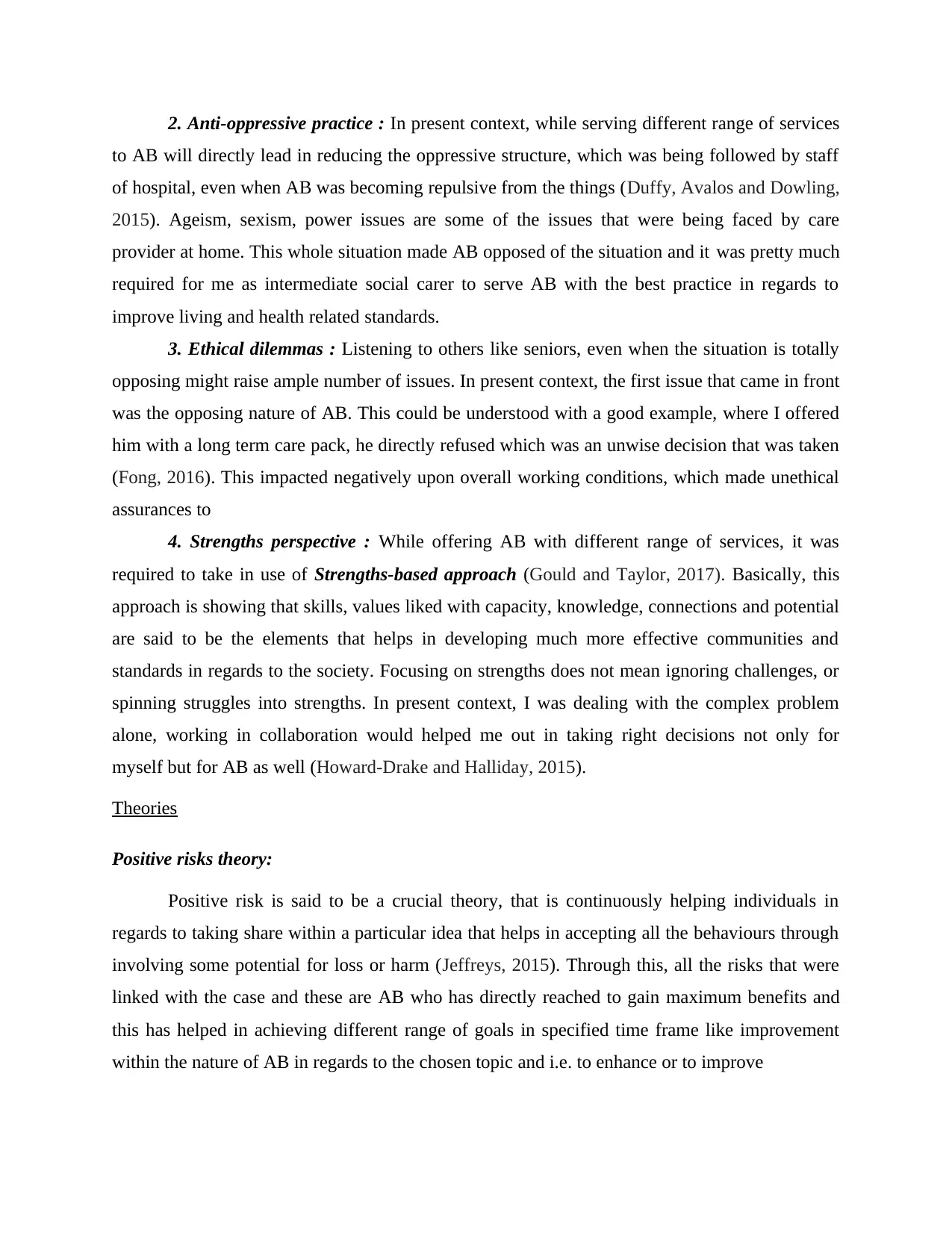
2. Anti-oppressive practice : In present context, while serving different range of services
to AB will directly lead in reducing the oppressive structure, which was being followed by staff
of hospital, even when AB was becoming repulsive from the things (Duffy, Avalos and Dowling,
2015). Ageism, sexism, power issues are some of the issues that were being faced by care
provider at home. This whole situation made AB opposed of the situation and it was pretty much
required for me as intermediate social carer to serve AB with the best practice in regards to
improve living and health related standards.
3. Ethical dilemmas : Listening to others like seniors, even when the situation is totally
opposing might raise ample number of issues. In present context, the first issue that came in front
was the opposing nature of AB. This could be understood with a good example, where I offered
him with a long term care pack, he directly refused which was an unwise decision that was taken
(Fong, 2016). This impacted negatively upon overall working conditions, which made unethical
assurances to
4. Strengths perspective : While offering AB with different range of services, it was
required to take in use of Strengths-based approach (Gould and Taylor, 2017). Basically, this
approach is showing that skills, values liked with capacity, knowledge, connections and potential
are said to be the elements that helps in developing much more effective communities and
standards in regards to the society. Focusing on strengths does not mean ignoring challenges, or
spinning struggles into strengths. In present context, I was dealing with the complex problem
alone, working in collaboration would helped me out in taking right decisions not only for
myself but for AB as well (Howard-Drake and Halliday, 2015).
Theories
Positive risks theory:
Positive risk is said to be a crucial theory, that is continuously helping individuals in
regards to taking share within a particular idea that helps in accepting all the behaviours through
involving some potential for loss or harm (Jeffreys, 2015). Through this, all the risks that were
linked with the case and these are AB who has directly reached to gain maximum benefits and
this has helped in achieving different range of goals in specified time frame like improvement
within the nature of AB in regards to the chosen topic and i.e. to enhance or to improve
to AB will directly lead in reducing the oppressive structure, which was being followed by staff
of hospital, even when AB was becoming repulsive from the things (Duffy, Avalos and Dowling,
2015). Ageism, sexism, power issues are some of the issues that were being faced by care
provider at home. This whole situation made AB opposed of the situation and it was pretty much
required for me as intermediate social carer to serve AB with the best practice in regards to
improve living and health related standards.
3. Ethical dilemmas : Listening to others like seniors, even when the situation is totally
opposing might raise ample number of issues. In present context, the first issue that came in front
was the opposing nature of AB. This could be understood with a good example, where I offered
him with a long term care pack, he directly refused which was an unwise decision that was taken
(Fong, 2016). This impacted negatively upon overall working conditions, which made unethical
assurances to
4. Strengths perspective : While offering AB with different range of services, it was
required to take in use of Strengths-based approach (Gould and Taylor, 2017). Basically, this
approach is showing that skills, values liked with capacity, knowledge, connections and potential
are said to be the elements that helps in developing much more effective communities and
standards in regards to the society. Focusing on strengths does not mean ignoring challenges, or
spinning struggles into strengths. In present context, I was dealing with the complex problem
alone, working in collaboration would helped me out in taking right decisions not only for
myself but for AB as well (Howard-Drake and Halliday, 2015).
Theories
Positive risks theory:
Positive risk is said to be a crucial theory, that is continuously helping individuals in
regards to taking share within a particular idea that helps in accepting all the behaviours through
involving some potential for loss or harm (Jeffreys, 2015). Through this, all the risks that were
linked with the case and these are AB who has directly reached to gain maximum benefits and
this has helped in achieving different range of goals in specified time frame like improvement
within the nature of AB in regards to the chosen topic and i.e. to enhance or to improve
Secure Best Marks with AI Grader
Need help grading? Try our AI Grader for instant feedback on your assignments.
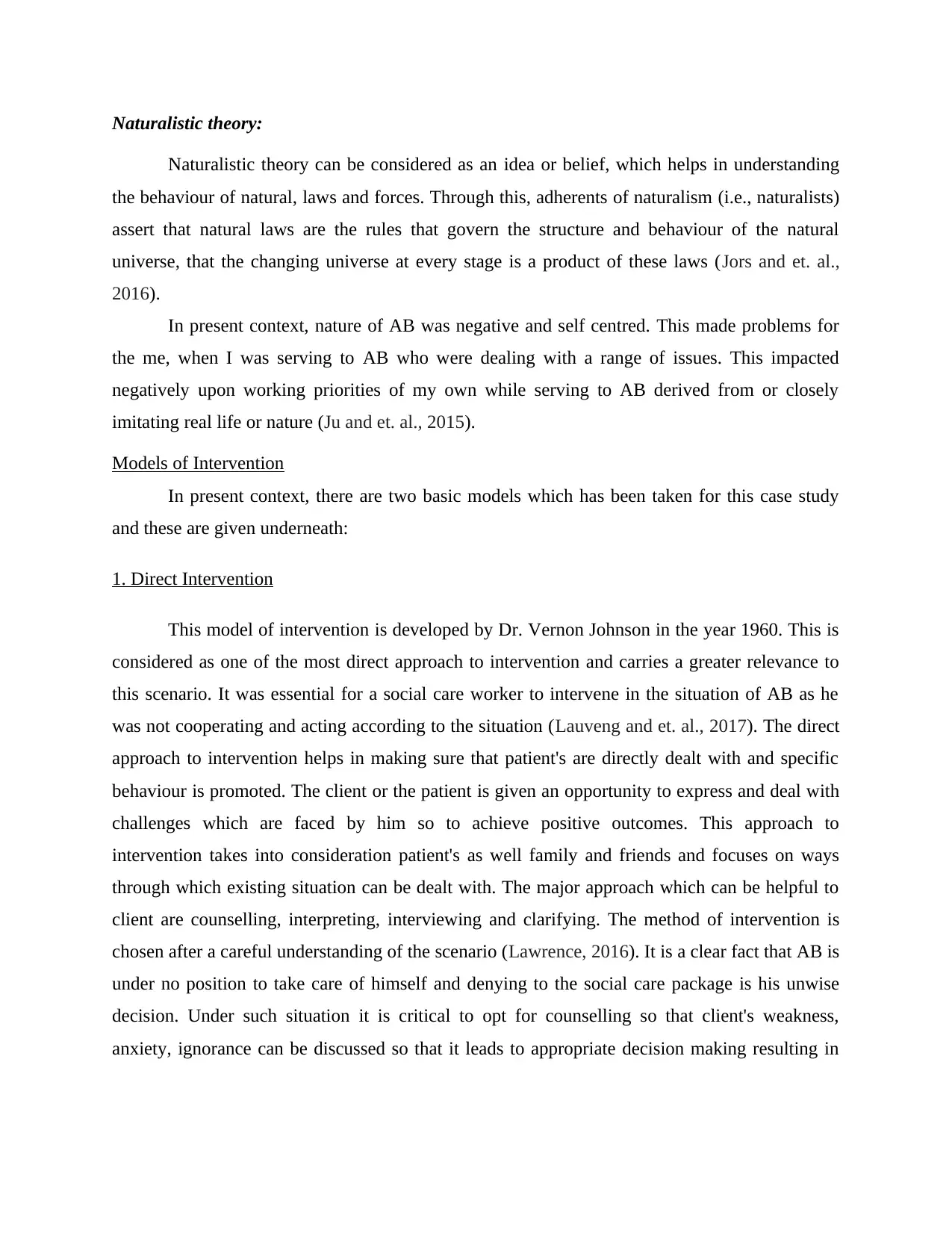
Naturalistic theory:
Naturalistic theory can be considered as an idea or belief, which helps in understanding
the behaviour of natural, laws and forces. Through this, adherents of naturalism (i.e., naturalists)
assert that natural laws are the rules that govern the structure and behaviour of the natural
universe, that the changing universe at every stage is a product of these laws (Jors and et. al.,
2016).
In present context, nature of AB was negative and self centred. This made problems for
the me, when I was serving to AB who were dealing with a range of issues. This impacted
negatively upon working priorities of my own while serving to AB derived from or closely
imitating real life or nature (Ju and et. al., 2015).
Models of Intervention
In present context, there are two basic models which has been taken for this case study
and these are given underneath:
1. Direct Intervention
This model of intervention is developed by Dr. Vernon Johnson in the year 1960. This is
considered as one of the most direct approach to intervention and carries a greater relevance to
this scenario. It was essential for a social care worker to intervene in the situation of AB as he
was not cooperating and acting according to the situation (Lauveng and et. al., 2017). The direct
approach to intervention helps in making sure that patient's are directly dealt with and specific
behaviour is promoted. The client or the patient is given an opportunity to express and deal with
challenges which are faced by him so to achieve positive outcomes. This approach to
intervention takes into consideration patient's as well family and friends and focuses on ways
through which existing situation can be dealt with. The major approach which can be helpful to
client are counselling, interpreting, interviewing and clarifying. The method of intervention is
chosen after a careful understanding of the scenario (Lawrence, 2016). It is a clear fact that AB is
under no position to take care of himself and denying to the social care package is his unwise
decision. Under such situation it is critical to opt for counselling so that client's weakness,
anxiety, ignorance can be discussed so that it leads to appropriate decision making resulting in
Naturalistic theory can be considered as an idea or belief, which helps in understanding
the behaviour of natural, laws and forces. Through this, adherents of naturalism (i.e., naturalists)
assert that natural laws are the rules that govern the structure and behaviour of the natural
universe, that the changing universe at every stage is a product of these laws (Jors and et. al.,
2016).
In present context, nature of AB was negative and self centred. This made problems for
the me, when I was serving to AB who were dealing with a range of issues. This impacted
negatively upon working priorities of my own while serving to AB derived from or closely
imitating real life or nature (Ju and et. al., 2015).
Models of Intervention
In present context, there are two basic models which has been taken for this case study
and these are given underneath:
1. Direct Intervention
This model of intervention is developed by Dr. Vernon Johnson in the year 1960. This is
considered as one of the most direct approach to intervention and carries a greater relevance to
this scenario. It was essential for a social care worker to intervene in the situation of AB as he
was not cooperating and acting according to the situation (Lauveng and et. al., 2017). The direct
approach to intervention helps in making sure that patient's are directly dealt with and specific
behaviour is promoted. The client or the patient is given an opportunity to express and deal with
challenges which are faced by him so to achieve positive outcomes. This approach to
intervention takes into consideration patient's as well family and friends and focuses on ways
through which existing situation can be dealt with. The major approach which can be helpful to
client are counselling, interpreting, interviewing and clarifying. The method of intervention is
chosen after a careful understanding of the scenario (Lawrence, 2016). It is a clear fact that AB is
under no position to take care of himself and denying to the social care package is his unwise
decision. Under such situation it is critical to opt for counselling so that client's weakness,
anxiety, ignorance can be discussed so that it leads to appropriate decision making resulting in
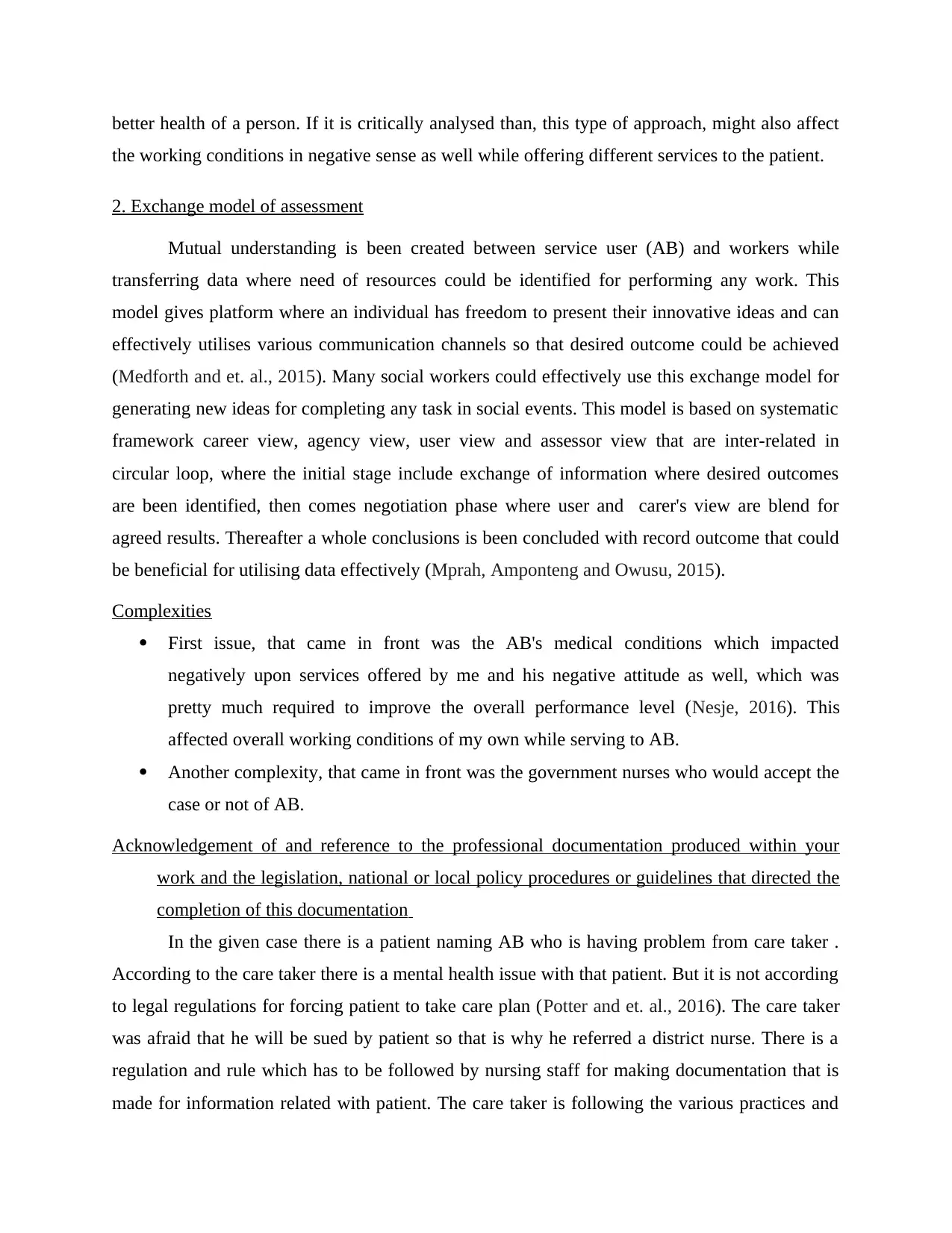
better health of a person. If it is critically analysed than, this type of approach, might also affect
the working conditions in negative sense as well while offering different services to the patient.
2. Exchange model of assessment
Mutual understanding is been created between service user (AB) and workers while
transferring data where need of resources could be identified for performing any work. This
model gives platform where an individual has freedom to present their innovative ideas and can
effectively utilises various communication channels so that desired outcome could be achieved
(Medforth and et. al., 2015). Many social workers could effectively use this exchange model for
generating new ideas for completing any task in social events. This model is based on systematic
framework career view, agency view, user view and assessor view that are inter-related in
circular loop, where the initial stage include exchange of information where desired outcomes
are been identified, then comes negotiation phase where user and carer's view are blend for
agreed results. Thereafter a whole conclusions is been concluded with record outcome that could
be beneficial for utilising data effectively (Mprah, Amponteng and Owusu, 2015).
Complexities
First issue, that came in front was the AB's medical conditions which impacted
negatively upon services offered by me and his negative attitude as well, which was
pretty much required to improve the overall performance level (Nesje, 2016). This
affected overall working conditions of my own while serving to AB.
Another complexity, that came in front was the government nurses who would accept the
case or not of AB.
Acknowledgement of and reference to the professional documentation produced within your
work and the legislation, national or local policy procedures or guidelines that directed the
completion of this documentation
In the given case there is a patient naming AB who is having problem from care taker .
According to the care taker there is a mental health issue with that patient. But it is not according
to legal regulations for forcing patient to take care plan (Potter and et. al., 2016). The care taker
was afraid that he will be sued by patient so that is why he referred a district nurse. There is a
regulation and rule which has to be followed by nursing staff for making documentation that is
made for information related with patient. The care taker is following the various practices and
the working conditions in negative sense as well while offering different services to the patient.
2. Exchange model of assessment
Mutual understanding is been created between service user (AB) and workers while
transferring data where need of resources could be identified for performing any work. This
model gives platform where an individual has freedom to present their innovative ideas and can
effectively utilises various communication channels so that desired outcome could be achieved
(Medforth and et. al., 2015). Many social workers could effectively use this exchange model for
generating new ideas for completing any task in social events. This model is based on systematic
framework career view, agency view, user view and assessor view that are inter-related in
circular loop, where the initial stage include exchange of information where desired outcomes
are been identified, then comes negotiation phase where user and carer's view are blend for
agreed results. Thereafter a whole conclusions is been concluded with record outcome that could
be beneficial for utilising data effectively (Mprah, Amponteng and Owusu, 2015).
Complexities
First issue, that came in front was the AB's medical conditions which impacted
negatively upon services offered by me and his negative attitude as well, which was
pretty much required to improve the overall performance level (Nesje, 2016). This
affected overall working conditions of my own while serving to AB.
Another complexity, that came in front was the government nurses who would accept the
case or not of AB.
Acknowledgement of and reference to the professional documentation produced within your
work and the legislation, national or local policy procedures or guidelines that directed the
completion of this documentation
In the given case there is a patient naming AB who is having problem from care taker .
According to the care taker there is a mental health issue with that patient. But it is not according
to legal regulations for forcing patient to take care plan (Potter and et. al., 2016). The care taker
was afraid that he will be sued by patient so that is why he referred a district nurse. There is a
regulation and rule which has to be followed by nursing staff for making documentation that is
made for information related with patient. The care taker is following the various practices and
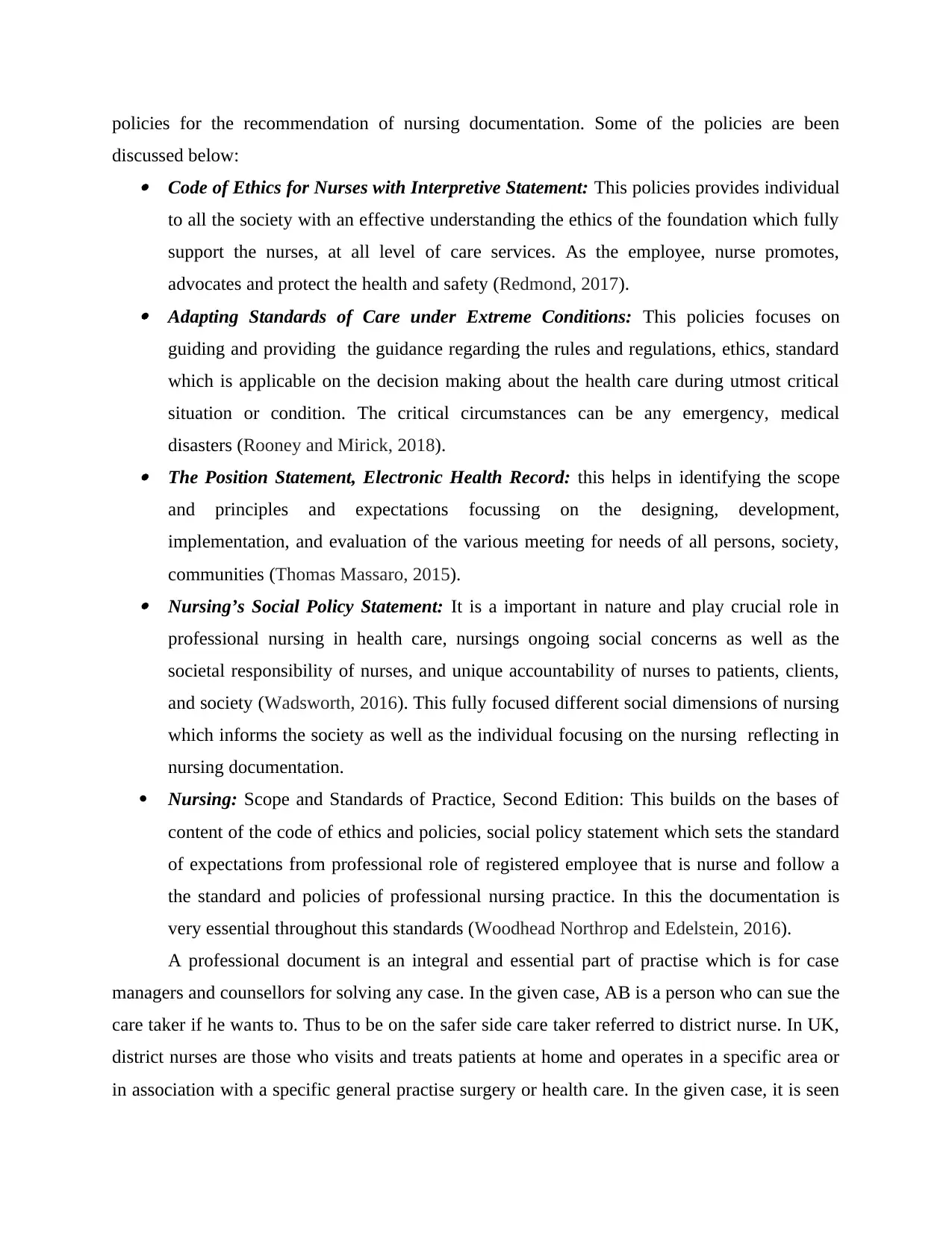
policies for the recommendation of nursing documentation. Some of the policies are been
discussed below: Code of Ethics for Nurses with Interpretive Statement: This policies provides individual
to all the society with an effective understanding the ethics of the foundation which fully
support the nurses, at all level of care services. As the employee, nurse promotes,
advocates and protect the health and safety (Redmond, 2017). Adapting Standards of Care under Extreme Conditions: This policies focuses on
guiding and providing the guidance regarding the rules and regulations, ethics, standard
which is applicable on the decision making about the health care during utmost critical
situation or condition. The critical circumstances can be any emergency, medical
disasters (Rooney and Mirick, 2018). The Position Statement, Electronic Health Record: this helps in identifying the scope
and principles and expectations focussing on the designing, development,
implementation, and evaluation of the various meeting for needs of all persons, society,
communities (Thomas Massaro, 2015). Nursing’s Social Policy Statement: It is a important in nature and play crucial role in
professional nursing in health care, nursings ongoing social concerns as well as the
societal responsibility of nurses, and unique accountability of nurses to patients, clients,
and society (Wadsworth, 2016). This fully focused different social dimensions of nursing
which informs the society as well as the individual focusing on the nursing reflecting in
nursing documentation.
Nursing: Scope and Standards of Practice, Second Edition: This builds on the bases of
content of the code of ethics and policies, social policy statement which sets the standard
of expectations from professional role of registered employee that is nurse and follow a
the standard and policies of professional nursing practice. In this the documentation is
very essential throughout this standards (Woodhead Northrop and Edelstein, 2016).
A professional document is an integral and essential part of practise which is for case
managers and counsellors for solving any case. In the given case, AB is a person who can sue the
care taker if he wants to. Thus to be on the safer side care taker referred to district nurse. In UK,
district nurses are those who visits and treats patients at home and operates in a specific area or
in association with a specific general practise surgery or health care. In the given case, it is seen
discussed below: Code of Ethics for Nurses with Interpretive Statement: This policies provides individual
to all the society with an effective understanding the ethics of the foundation which fully
support the nurses, at all level of care services. As the employee, nurse promotes,
advocates and protect the health and safety (Redmond, 2017). Adapting Standards of Care under Extreme Conditions: This policies focuses on
guiding and providing the guidance regarding the rules and regulations, ethics, standard
which is applicable on the decision making about the health care during utmost critical
situation or condition. The critical circumstances can be any emergency, medical
disasters (Rooney and Mirick, 2018). The Position Statement, Electronic Health Record: this helps in identifying the scope
and principles and expectations focussing on the designing, development,
implementation, and evaluation of the various meeting for needs of all persons, society,
communities (Thomas Massaro, 2015). Nursing’s Social Policy Statement: It is a important in nature and play crucial role in
professional nursing in health care, nursings ongoing social concerns as well as the
societal responsibility of nurses, and unique accountability of nurses to patients, clients,
and society (Wadsworth, 2016). This fully focused different social dimensions of nursing
which informs the society as well as the individual focusing on the nursing reflecting in
nursing documentation.
Nursing: Scope and Standards of Practice, Second Edition: This builds on the bases of
content of the code of ethics and policies, social policy statement which sets the standard
of expectations from professional role of registered employee that is nurse and follow a
the standard and policies of professional nursing practice. In this the documentation is
very essential throughout this standards (Woodhead Northrop and Edelstein, 2016).
A professional document is an integral and essential part of practise which is for case
managers and counsellors for solving any case. In the given case, AB is a person who can sue the
care taker if he wants to. Thus to be on the safer side care taker referred to district nurse. In UK,
district nurses are those who visits and treats patients at home and operates in a specific area or
in association with a specific general practise surgery or health care. In the given case, it is seen
Paraphrase This Document
Need a fresh take? Get an instant paraphrase of this document with our AI Paraphraser
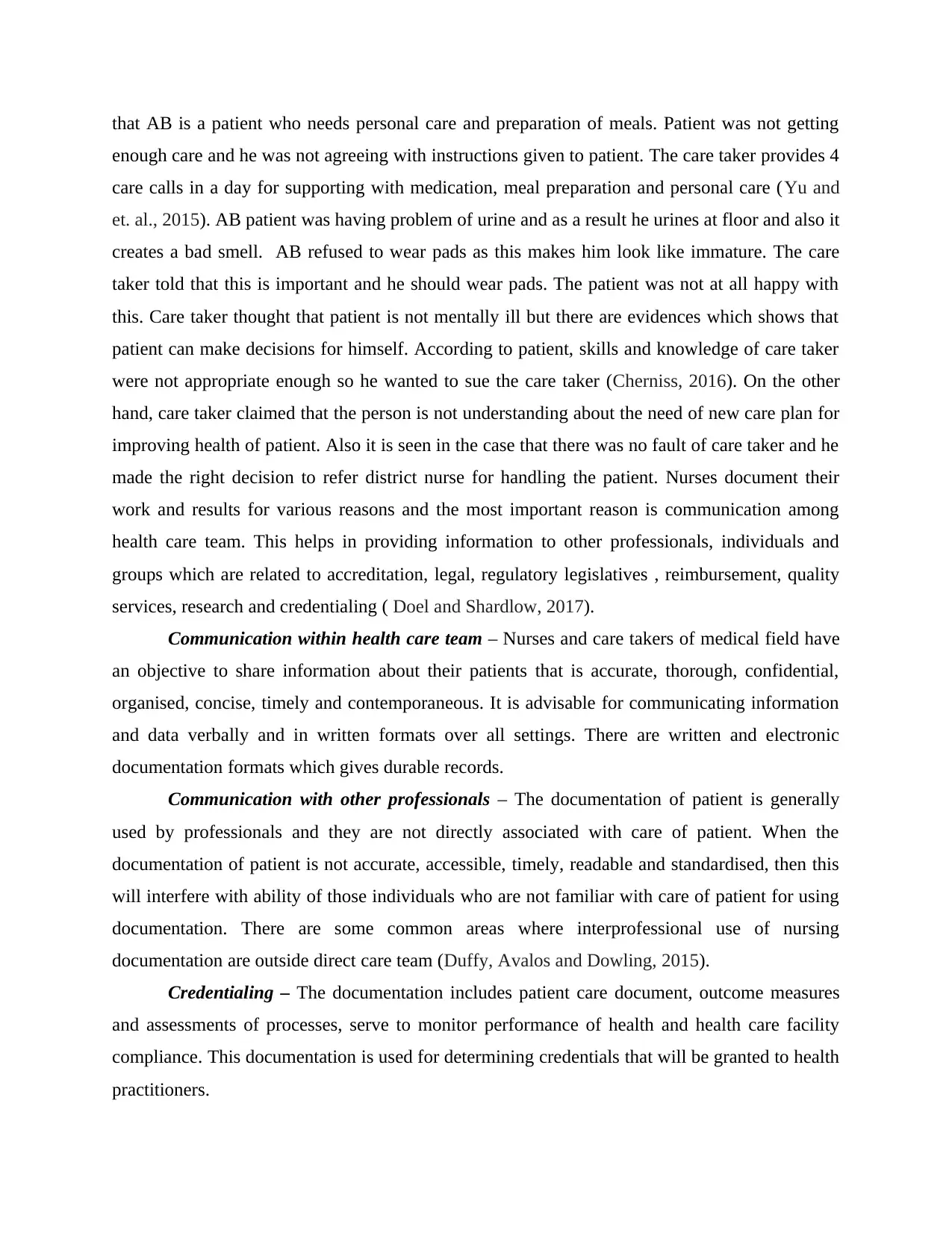
that AB is a patient who needs personal care and preparation of meals. Patient was not getting
enough care and he was not agreeing with instructions given to patient. The care taker provides 4
care calls in a day for supporting with medication, meal preparation and personal care (Yu and
et. al., 2015). AB patient was having problem of urine and as a result he urines at floor and also it
creates a bad smell. AB refused to wear pads as this makes him look like immature. The care
taker told that this is important and he should wear pads. The patient was not at all happy with
this. Care taker thought that patient is not mentally ill but there are evidences which shows that
patient can make decisions for himself. According to patient, skills and knowledge of care taker
were not appropriate enough so he wanted to sue the care taker (Cherniss, 2016). On the other
hand, care taker claimed that the person is not understanding about the need of new care plan for
improving health of patient. Also it is seen in the case that there was no fault of care taker and he
made the right decision to refer district nurse for handling the patient. Nurses document their
work and results for various reasons and the most important reason is communication among
health care team. This helps in providing information to other professionals, individuals and
groups which are related to accreditation, legal, regulatory legislatives , reimbursement, quality
services, research and credentialing ( Doel and Shardlow, 2017).
Communication within health care team – Nurses and care takers of medical field have
an objective to share information about their patients that is accurate, thorough, confidential,
organised, concise, timely and contemporaneous. It is advisable for communicating information
and data verbally and in written formats over all settings. There are written and electronic
documentation formats which gives durable records.
Communication with other professionals – The documentation of patient is generally
used by professionals and they are not directly associated with care of patient. When the
documentation of patient is not accurate, accessible, timely, readable and standardised, then this
will interfere with ability of those individuals who are not familiar with care of patient for using
documentation. There are some common areas where interprofessional use of nursing
documentation are outside direct care team (Duffy, Avalos and Dowling, 2015).
Credentialing – The documentation includes patient care document, outcome measures
and assessments of processes, serve to monitor performance of health and health care facility
compliance. This documentation is used for determining credentials that will be granted to health
practitioners.
enough care and he was not agreeing with instructions given to patient. The care taker provides 4
care calls in a day for supporting with medication, meal preparation and personal care (Yu and
et. al., 2015). AB patient was having problem of urine and as a result he urines at floor and also it
creates a bad smell. AB refused to wear pads as this makes him look like immature. The care
taker told that this is important and he should wear pads. The patient was not at all happy with
this. Care taker thought that patient is not mentally ill but there are evidences which shows that
patient can make decisions for himself. According to patient, skills and knowledge of care taker
were not appropriate enough so he wanted to sue the care taker (Cherniss, 2016). On the other
hand, care taker claimed that the person is not understanding about the need of new care plan for
improving health of patient. Also it is seen in the case that there was no fault of care taker and he
made the right decision to refer district nurse for handling the patient. Nurses document their
work and results for various reasons and the most important reason is communication among
health care team. This helps in providing information to other professionals, individuals and
groups which are related to accreditation, legal, regulatory legislatives , reimbursement, quality
services, research and credentialing ( Doel and Shardlow, 2017).
Communication within health care team – Nurses and care takers of medical field have
an objective to share information about their patients that is accurate, thorough, confidential,
organised, concise, timely and contemporaneous. It is advisable for communicating information
and data verbally and in written formats over all settings. There are written and electronic
documentation formats which gives durable records.
Communication with other professionals – The documentation of patient is generally
used by professionals and they are not directly associated with care of patient. When the
documentation of patient is not accurate, accessible, timely, readable and standardised, then this
will interfere with ability of those individuals who are not familiar with care of patient for using
documentation. There are some common areas where interprofessional use of nursing
documentation are outside direct care team (Duffy, Avalos and Dowling, 2015).
Credentialing – The documentation includes patient care document, outcome measures
and assessments of processes, serve to monitor performance of health and health care facility
compliance. This documentation is used for determining credentials that will be granted to health
practitioners.
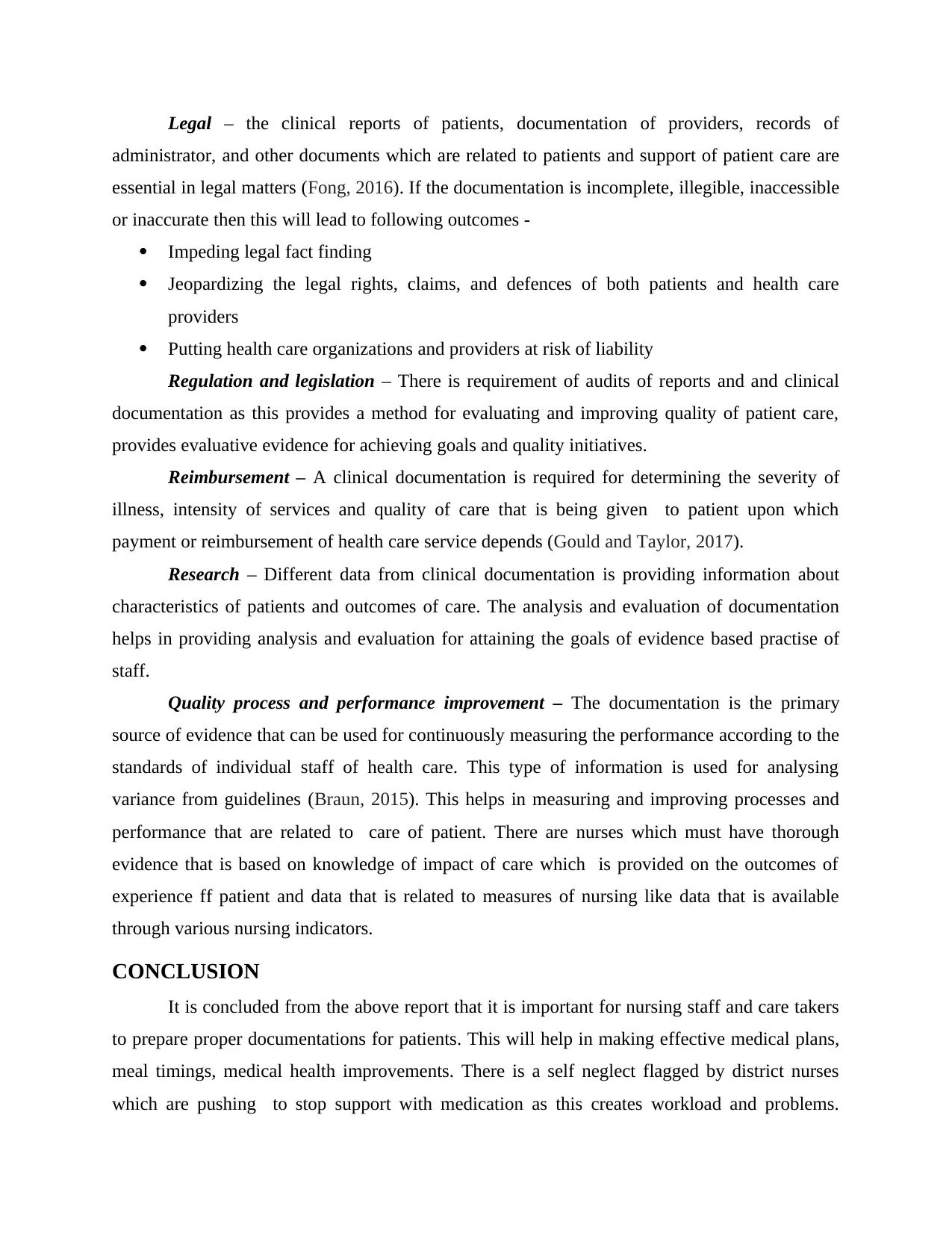
Legal – the clinical reports of patients, documentation of providers, records of
administrator, and other documents which are related to patients and support of patient care are
essential in legal matters (Fong, 2016). If the documentation is incomplete, illegible, inaccessible
or inaccurate then this will lead to following outcomes -
Impeding legal fact finding
Jeopardizing the legal rights, claims, and defences of both patients and health care
providers
Putting health care organizations and providers at risk of liability
Regulation and legislation – There is requirement of audits of reports and and clinical
documentation as this provides a method for evaluating and improving quality of patient care,
provides evaluative evidence for achieving goals and quality initiatives.
Reimbursement – A clinical documentation is required for determining the severity of
illness, intensity of services and quality of care that is being given to patient upon which
payment or reimbursement of health care service depends (Gould and Taylor, 2017).
Research – Different data from clinical documentation is providing information about
characteristics of patients and outcomes of care. The analysis and evaluation of documentation
helps in providing analysis and evaluation for attaining the goals of evidence based practise of
staff.
Quality process and performance improvement – The documentation is the primary
source of evidence that can be used for continuously measuring the performance according to the
standards of individual staff of health care. This type of information is used for analysing
variance from guidelines (Braun, 2015). This helps in measuring and improving processes and
performance that are related to care of patient. There are nurses which must have thorough
evidence that is based on knowledge of impact of care which is provided on the outcomes of
experience ff patient and data that is related to measures of nursing like data that is available
through various nursing indicators.
CONCLUSION
It is concluded from the above report that it is important for nursing staff and care takers
to prepare proper documentations for patients. This will help in making effective medical plans,
meal timings, medical health improvements. There is a self neglect flagged by district nurses
which are pushing to stop support with medication as this creates workload and problems.
administrator, and other documents which are related to patients and support of patient care are
essential in legal matters (Fong, 2016). If the documentation is incomplete, illegible, inaccessible
or inaccurate then this will lead to following outcomes -
Impeding legal fact finding
Jeopardizing the legal rights, claims, and defences of both patients and health care
providers
Putting health care organizations and providers at risk of liability
Regulation and legislation – There is requirement of audits of reports and and clinical
documentation as this provides a method for evaluating and improving quality of patient care,
provides evaluative evidence for achieving goals and quality initiatives.
Reimbursement – A clinical documentation is required for determining the severity of
illness, intensity of services and quality of care that is being given to patient upon which
payment or reimbursement of health care service depends (Gould and Taylor, 2017).
Research – Different data from clinical documentation is providing information about
characteristics of patients and outcomes of care. The analysis and evaluation of documentation
helps in providing analysis and evaluation for attaining the goals of evidence based practise of
staff.
Quality process and performance improvement – The documentation is the primary
source of evidence that can be used for continuously measuring the performance according to the
standards of individual staff of health care. This type of information is used for analysing
variance from guidelines (Braun, 2015). This helps in measuring and improving processes and
performance that are related to care of patient. There are nurses which must have thorough
evidence that is based on knowledge of impact of care which is provided on the outcomes of
experience ff patient and data that is related to measures of nursing like data that is available
through various nursing indicators.
CONCLUSION
It is concluded from the above report that it is important for nursing staff and care takers
to prepare proper documentations for patients. This will help in making effective medical plans,
meal timings, medical health improvements. There is a self neglect flagged by district nurses
which are pushing to stop support with medication as this creates workload and problems.
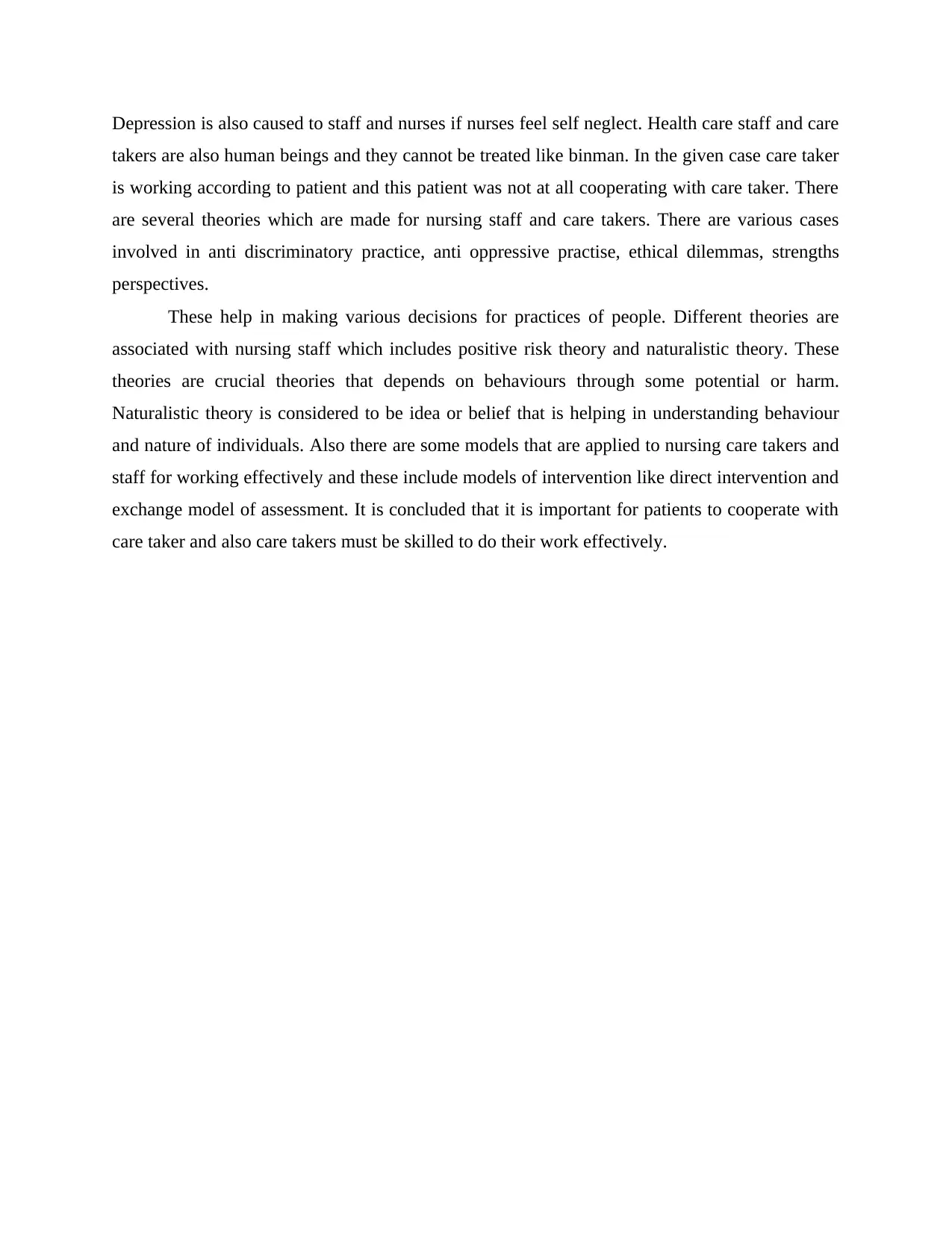
Depression is also caused to staff and nurses if nurses feel self neglect. Health care staff and care
takers are also human beings and they cannot be treated like binman. In the given case care taker
is working according to patient and this patient was not at all cooperating with care taker. There
are several theories which are made for nursing staff and care takers. There are various cases
involved in anti discriminatory practice, anti oppressive practise, ethical dilemmas, strengths
perspectives.
These help in making various decisions for practices of people. Different theories are
associated with nursing staff which includes positive risk theory and naturalistic theory. These
theories are crucial theories that depends on behaviours through some potential or harm.
Naturalistic theory is considered to be idea or belief that is helping in understanding behaviour
and nature of individuals. Also there are some models that are applied to nursing care takers and
staff for working effectively and these include models of intervention like direct intervention and
exchange model of assessment. It is concluded that it is important for patients to cooperate with
care taker and also care takers must be skilled to do their work effectively.
takers are also human beings and they cannot be treated like binman. In the given case care taker
is working according to patient and this patient was not at all cooperating with care taker. There
are several theories which are made for nursing staff and care takers. There are various cases
involved in anti discriminatory practice, anti oppressive practise, ethical dilemmas, strengths
perspectives.
These help in making various decisions for practices of people. Different theories are
associated with nursing staff which includes positive risk theory and naturalistic theory. These
theories are crucial theories that depends on behaviours through some potential or harm.
Naturalistic theory is considered to be idea or belief that is helping in understanding behaviour
and nature of individuals. Also there are some models that are applied to nursing care takers and
staff for working effectively and these include models of intervention like direct intervention and
exchange model of assessment. It is concluded that it is important for patients to cooperate with
care taker and also care takers must be skilled to do their work effectively.
Secure Best Marks with AI Grader
Need help grading? Try our AI Grader for instant feedback on your assignments.
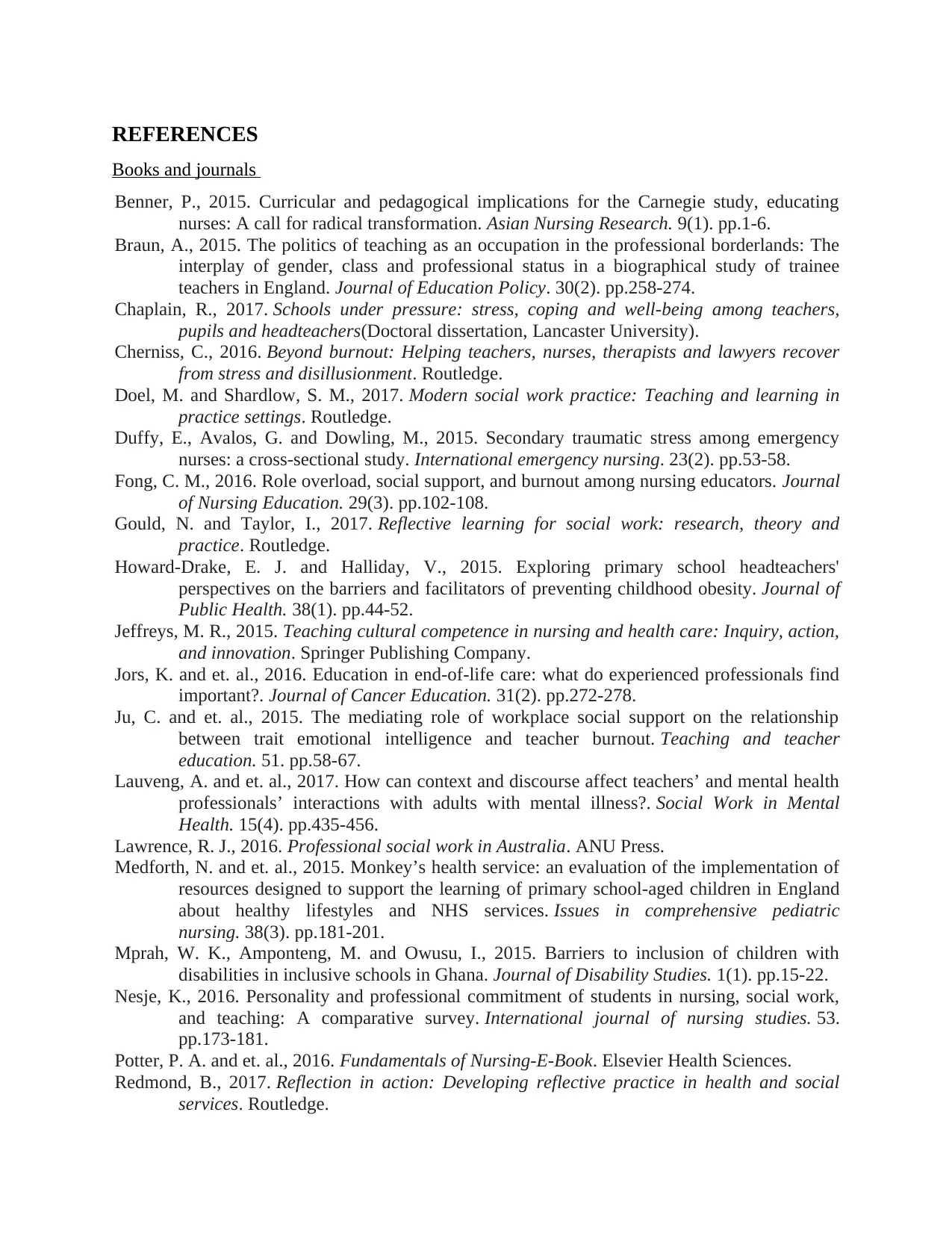
REFERENCES
Books and journals
Benner, P., 2015. Curricular and pedagogical implications for the Carnegie study, educating
nurses: A call for radical transformation. Asian Nursing Research. 9(1). pp.1-6.
Braun, A., 2015. The politics of teaching as an occupation in the professional borderlands: The
interplay of gender, class and professional status in a biographical study of trainee
teachers in England. Journal of Education Policy. 30(2). pp.258-274.
Chaplain, R., 2017. Schools under pressure: stress, coping and well-being among teachers,
pupils and headteachers(Doctoral dissertation, Lancaster University).
Cherniss, C., 2016. Beyond burnout: Helping teachers, nurses, therapists and lawyers recover
from stress and disillusionment. Routledge.
Doel, M. and Shardlow, S. M., 2017. Modern social work practice: Teaching and learning in
practice settings. Routledge.
Duffy, E., Avalos, G. and Dowling, M., 2015. Secondary traumatic stress among emergency
nurses: a cross-sectional study. International emergency nursing. 23(2). pp.53-58.
Fong, C. M., 2016. Role overload, social support, and burnout among nursing educators. Journal
of Nursing Education. 29(3). pp.102-108.
Gould, N. and Taylor, I., 2017. Reflective learning for social work: research, theory and
practice. Routledge.
Howard-Drake, E. J. and Halliday, V., 2015. Exploring primary school headteachers'
perspectives on the barriers and facilitators of preventing childhood obesity. Journal of
Public Health. 38(1). pp.44-52.
Jeffreys, M. R., 2015. Teaching cultural competence in nursing and health care: Inquiry, action,
and innovation. Springer Publishing Company.
Jors, K. and et. al., 2016. Education in end-of-life care: what do experienced professionals find
important?. Journal of Cancer Education. 31(2). pp.272-278.
Ju, C. and et. al., 2015. The mediating role of workplace social support on the relationship
between trait emotional intelligence and teacher burnout. Teaching and teacher
education. 51. pp.58-67.
Lauveng, A. and et. al., 2017. How can context and discourse affect teachers’ and mental health
professionals’ interactions with adults with mental illness?. Social Work in Mental
Health. 15(4). pp.435-456.
Lawrence, R. J., 2016. Professional social work in Australia. ANU Press.
Medforth, N. and et. al., 2015. Monkey’s health service: an evaluation of the implementation of
resources designed to support the learning of primary school-aged children in England
about healthy lifestyles and NHS services. Issues in comprehensive pediatric
nursing. 38(3). pp.181-201.
Mprah, W. K., Amponteng, M. and Owusu, I., 2015. Barriers to inclusion of children with
disabilities in inclusive schools in Ghana. Journal of Disability Studies. 1(1). pp.15-22.
Nesje, K., 2016. Personality and professional commitment of students in nursing, social work,
and teaching: A comparative survey. International journal of nursing studies. 53.
pp.173-181.
Potter, P. A. and et. al., 2016. Fundamentals of Nursing-E-Book. Elsevier Health Sciences.
Redmond, B., 2017. Reflection in action: Developing reflective practice in health and social
services. Routledge.
Books and journals
Benner, P., 2015. Curricular and pedagogical implications for the Carnegie study, educating
nurses: A call for radical transformation. Asian Nursing Research. 9(1). pp.1-6.
Braun, A., 2015. The politics of teaching as an occupation in the professional borderlands: The
interplay of gender, class and professional status in a biographical study of trainee
teachers in England. Journal of Education Policy. 30(2). pp.258-274.
Chaplain, R., 2017. Schools under pressure: stress, coping and well-being among teachers,
pupils and headteachers(Doctoral dissertation, Lancaster University).
Cherniss, C., 2016. Beyond burnout: Helping teachers, nurses, therapists and lawyers recover
from stress and disillusionment. Routledge.
Doel, M. and Shardlow, S. M., 2017. Modern social work practice: Teaching and learning in
practice settings. Routledge.
Duffy, E., Avalos, G. and Dowling, M., 2015. Secondary traumatic stress among emergency
nurses: a cross-sectional study. International emergency nursing. 23(2). pp.53-58.
Fong, C. M., 2016. Role overload, social support, and burnout among nursing educators. Journal
of Nursing Education. 29(3). pp.102-108.
Gould, N. and Taylor, I., 2017. Reflective learning for social work: research, theory and
practice. Routledge.
Howard-Drake, E. J. and Halliday, V., 2015. Exploring primary school headteachers'
perspectives on the barriers and facilitators of preventing childhood obesity. Journal of
Public Health. 38(1). pp.44-52.
Jeffreys, M. R., 2015. Teaching cultural competence in nursing and health care: Inquiry, action,
and innovation. Springer Publishing Company.
Jors, K. and et. al., 2016. Education in end-of-life care: what do experienced professionals find
important?. Journal of Cancer Education. 31(2). pp.272-278.
Ju, C. and et. al., 2015. The mediating role of workplace social support on the relationship
between trait emotional intelligence and teacher burnout. Teaching and teacher
education. 51. pp.58-67.
Lauveng, A. and et. al., 2017. How can context and discourse affect teachers’ and mental health
professionals’ interactions with adults with mental illness?. Social Work in Mental
Health. 15(4). pp.435-456.
Lawrence, R. J., 2016. Professional social work in Australia. ANU Press.
Medforth, N. and et. al., 2015. Monkey’s health service: an evaluation of the implementation of
resources designed to support the learning of primary school-aged children in England
about healthy lifestyles and NHS services. Issues in comprehensive pediatric
nursing. 38(3). pp.181-201.
Mprah, W. K., Amponteng, M. and Owusu, I., 2015. Barriers to inclusion of children with
disabilities in inclusive schools in Ghana. Journal of Disability Studies. 1(1). pp.15-22.
Nesje, K., 2016. Personality and professional commitment of students in nursing, social work,
and teaching: A comparative survey. International journal of nursing studies. 53.
pp.173-181.
Potter, P. A. and et. al., 2016. Fundamentals of Nursing-E-Book. Elsevier Health Sciences.
Redmond, B., 2017. Reflection in action: Developing reflective practice in health and social
services. Routledge.
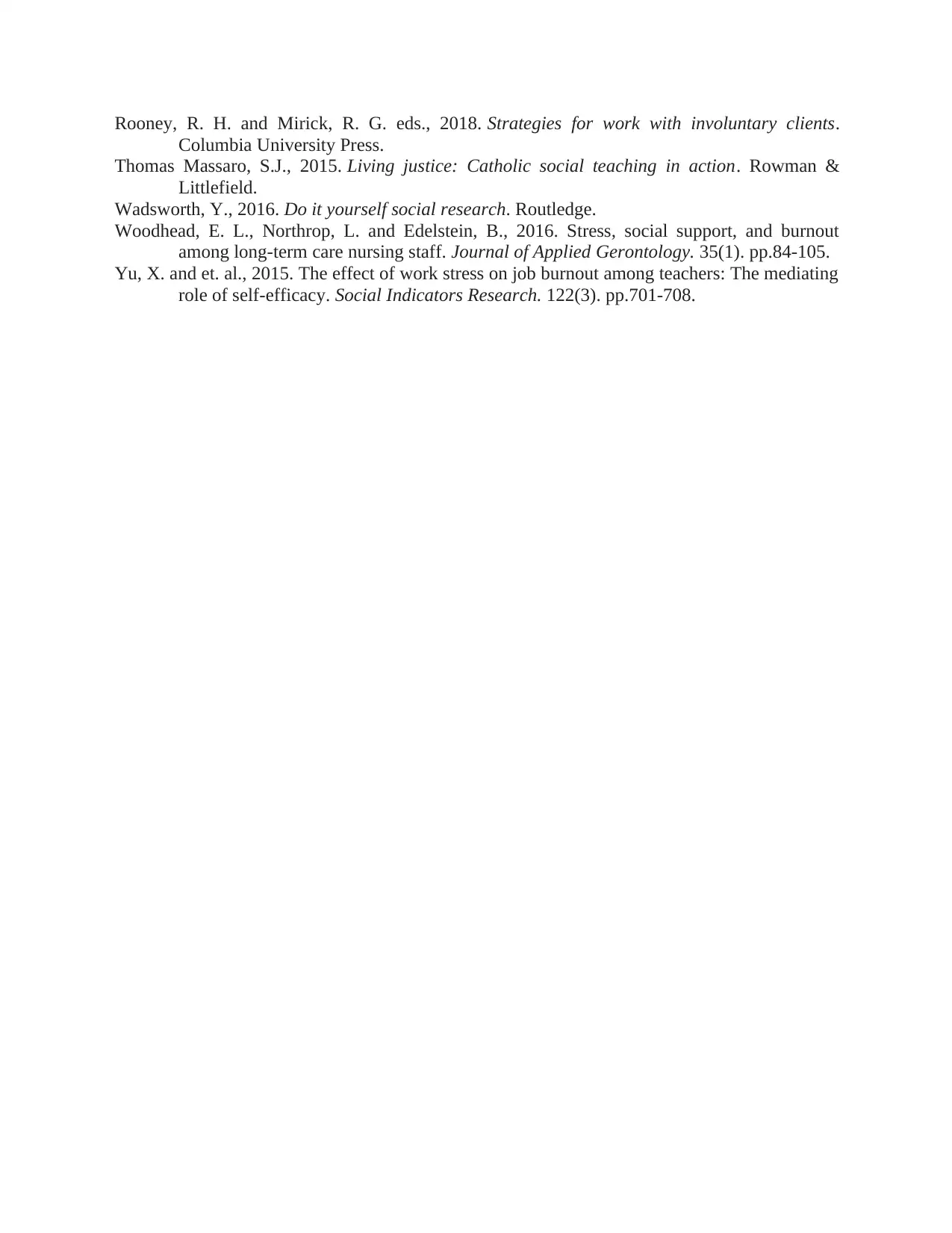
Rooney, R. H. and Mirick, R. G. eds., 2018. Strategies for work with involuntary clients.
Columbia University Press.
Thomas Massaro, S.J., 2015. Living justice: Catholic social teaching in action. Rowman &
Littlefield.
Wadsworth, Y., 2016. Do it yourself social research. Routledge.
Woodhead, E. L., Northrop, L. and Edelstein, B., 2016. Stress, social support, and burnout
among long-term care nursing staff. Journal of Applied Gerontology. 35(1). pp.84-105.
Yu, X. and et. al., 2015. The effect of work stress on job burnout among teachers: The mediating
role of self-efficacy. Social Indicators Research. 122(3). pp.701-708.
Columbia University Press.
Thomas Massaro, S.J., 2015. Living justice: Catholic social teaching in action. Rowman &
Littlefield.
Wadsworth, Y., 2016. Do it yourself social research. Routledge.
Woodhead, E. L., Northrop, L. and Edelstein, B., 2016. Stress, social support, and burnout
among long-term care nursing staff. Journal of Applied Gerontology. 35(1). pp.84-105.
Yu, X. and et. al., 2015. The effect of work stress on job burnout among teachers: The mediating
role of self-efficacy. Social Indicators Research. 122(3). pp.701-708.
1 out of 12
Related Documents
Your All-in-One AI-Powered Toolkit for Academic Success.
+13062052269
info@desklib.com
Available 24*7 on WhatsApp / Email
![[object Object]](/_next/static/media/star-bottom.7253800d.svg)
Unlock your academic potential
© 2024 | Zucol Services PVT LTD | All rights reserved.





